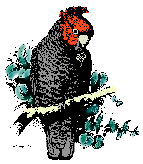Hi all
There is a fellow called Mike Tarburton who monitors all swift records and releases a short report each year. He presented to COG in 2015. Google his details or see the birding-aus chatline archive.
Many years ago, I remember seeing a flock of around 400 needletails over the Pine Ridge property in west Belconnen (before the grape vines went in). Most were hunting insects less than 15 metres off the ground. The noise was incredible.
A few years later I picked up this road-killed specimen on Coulter Drive:
Cheers
Anthony
On Mon, 15 Jan 2024 at 11:25, Kim Farley via Canberrabirds <> wrote:
Lovely. John Gould could write very nicely. I am touched by his describing the sky as being peopled with birds. 'Peopled' was a common usage in past times of course and was used to describe all sorts of things - but its still a charming way to describe
what others may have simply called a flock.
Kim
On Sun, 14 Jan 2024, 6:38 pm Geoffrey Dabb, <> wrote:
‘I have frequently observed in the middle of the hottest days, while lying prostrate on the ground with my eyes directed upwards, the cloudless blue sky peopled at an immense elevation by hundreds of these birds,
performing extensive curves and sweeping flights, doubtless attracted thither by the insects that soar aloft during serene weather …’ -
John Gould, 1840
Wow... that makes sense... cheers Philip
From: Canberrabirds <>
on behalf of Philip Veerman <>
Sent: Saturday, January 13, 2024 5:58:35 PM
To: 'Canberrabirds' <>
Subject: Re: [Canberrabirds] Hints and tips?
About that question. Could be many reasons but most likely suggestion is reduction in insect prey in northern Asia (maybe in Australia too) or in places along their migration
routes. Hard to dispute an actual actual decrease in population numbers because in past decades I (and most people), would encounter flocks of sometimes up to hundreds of these birds, several times a year and sometimes several days in succession at any one
place, through the summer. This would be in all places I lived in from around Melbourne to Brisbane. Rarely encountered like that in recent years and it has been a gradual decline. I would not think their distribution has changed at all, though I could be
wrong on that.
Philip
From: ben milbourne
Sent: Saturday, 13 January, 2024 5:00 PM
To: Kim Farley; Philip Veerman
Subject: Re: [Canberrabirds] Hints and tips?
Cheers Kim,
Wonder why their numbers are dwindling... also, could it be an actual decrease in population numbers or a shift in their distribution/range (yes possibly both). Were high numbers typical 10+ years ago?
From: Kim Farley <>
Sent: Saturday, January 13, 2024 4:54:39 PM
To: Philip Veerman <>
Cc: ben milbourne <>
Subject: Re: [Canberrabirds] Hints and tips?
Yes, they often soar in ahead of cloud banks, weather changes and thunderstorms but are also sometimes seen in clear skies. But there is no predicting when or where you will see them. Sometimes they may zoom in not far above your head - I have heard the
swoosh of their wings. But more often they are higher than that. A couple of times I have been looking at a soaring raptor and realised there were Needletails up there too. Becoming rare now, though flocks of many 100s used to be quite common. Last time
I saw a flock of that size was around 2012 down at Shoalhaven Heads
On Sat, Jan 13, 2024 at 4:44 PM Philip Veerman <> wrote:
Needletail maybe? (AKA swifts). Two species locally. As shown in relevant books. Outside, up in the sky, at whatever altitude, at almost any location. Most of my Canberra observations
have been when hanging out or taking in washing on the hills hoist. In Australia mostly in summer to early autumn. Probably most often in late afternoons and often before rains, although why that is the case must be a bit of a mystery. .
From: Canberrabirds [
On Behalf Of ben milbourne via Canberrabirds
Sent: Saturday, 13 January, 2024 4:08 PM
To:
Subject: [Canberrabirds] Hints and tips?
Dies anyone have some refined hints and tips for needlepoint observations? Locating, timing sighting etc?
--
This is the email announcement and discussion list of the Canberra Ornithologists Group.
Emails posted to the list that exceed 2 MB (2,000 kB) in size, including attachments, will be rejected.
All emails distributed via the list are archived at
http://bioacoustics.cse.unsw.edu.au/archives/html/canberrabirds. It is a condition of list membership that you agree to your contributions being archived.
Canberrabirds mailing list
https://lists.canberrabirds.org.au/mailman/listinfo/canberrabirds
--
This is the email announcement and discussion list of the Canberra Ornithologists Group.
Emails posted to the list that exceed 2 MB (2,000 kB) in size, including attachments, will be rejected.
All emails distributed via the list are archived at
http://bioacoustics.cse.unsw.edu.au/archives/html/canberrabirds. It is a condition of list membership that you agree to your contributions being archived.
Canberrabirds mailing list
https://lists.canberrabirds.org.au/mailman/listinfo/canberrabirds
--
This is the email announcement and discussion list of the Canberra Ornithologists Group.
Emails posted to the list that exceed 2 MB (2,000 kB) in size, including attachments, will be rejected.
All emails distributed via the list are archived at
http://bioacoustics.cse.unsw.edu.au/archives/html/canberrabirds. It is a condition of list membership that you agree to your contributions being archived.
Canberrabirds mailing list
https://lists.canberrabirds.org.au/mailman/listinfo/canberrabirds
 ATT00001.txt
ATT00001.txt
Description: ATT00001.txt
|

